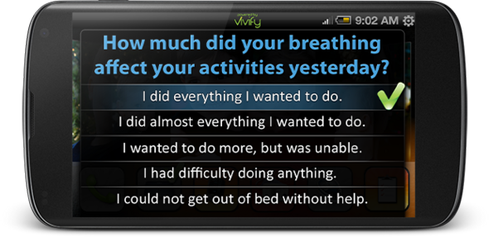How Mobile Devices Reshape Patient CareHow Mobile Devices Reshape Patient Care
Will a glorified pedometer change the way America does healthcare? And what is "mHealth," anyway? Five experts speak.


1 7 Portals Powering Patient Engagement
7 Portals Powering Patient Engagement (click image for larger view and for slideshow)
The wearable technology market is exploding, remote patient monitoring capabilities are more advanced than ever before, and the number of health apps available for download recently reached 100,000, according to the British Medical Journal. As a result, many say a mobile health (mHealth) revolution is underway.
Others are skeptical: Will a glorified pedometer change the way America does healthcare? And what is "mHealth," anyway?
information spoke with five experts scheduled to present at the mHealth Summit, Dec. 8-11 in Washington, D.C., to discuss this rapidly expanding space.
The experts had varying definitions of mHealth, but they were based off of the same core concept: mHealth is mobile technology that collects health data and transmits it to a designated location.
Right now, much of what is talked about in mHealth revolves around fitness and wellness technologies, like Fitbit or running apps. The success of those technologies is paving the way for mobile clinical products.
"Mobile fitness and wellness technologies have created a model of how all of this could work in healthcare," said Rick Valencia, senior VP and general manager at Qualcomm Life, a wireless health company.
[ Aging Americans will boost the need for innovative ways to manage health. See: As Boomers Become Seniors, Healthcare Technology Demand Grows.]
Making it work means finding a way to motivate people with chronic diseases to engage in their health. This is easier said than done.
"Fitness enthusiasts track their runs, measure their body fat, and take pictures of their food," said Corey Ackerman, president at Happtique, a health app distribution platform. "These people are already engaged. The trick is for providers to engage the about-to-be chronically ill to prevent those diseases."
Engaging those about-to-be-ill patients will mean developing a tailored approach to mHealth. Harry Greenspun, a physician and the senior adviser for healthcare transformation and technology at the Deloitte Center for Health Solutions, calls this approach "the four horseman of the mHealth apocalypse." For mHealth success, you need the right demographic, infrastructure, disease dynamics, and reimbursement structure.
To target the right demographic, you need to understand the patient's type and specific needs.
"It's one thing to be doing gamification around asthma in teens," Greenspun said. "It's another to treat hypertension in adults. Hypertension is just not fun. You don't see people swapping information on what their systolic blood pressure was yesterday. It's the type of condition and the patient population that's really conducive to what mobile does well."
Infrastructure is often overlooked, Greenspun said. If you're developing an app that needs continuous connectivity in an environment where that doesn't exist, you're not going to have much success.
Tailoring mHealth to a specific disease is just as important as tailoring it to an age group.
"Communities around cancer and asthma have a lot of online social interaction," Greenspun said. "But for a disease like gonorrhea, there's not a lot of checking in. There are privacy considerations. That needs to be taken into consideration."
A lot of mHealth models revolve around social pressure and competition. Take your medication or your doctor will be alerted; run those five miles or your friends will see you didn't.
Figure 1:  Slideshow: Remote Patient Monitoring.
Slideshow: Remote Patient Monitoring.
"In fitness, the social competition is motivating," Valencia said. "But people with congestive heart failure won't be in a socially competitive environment for how well they're taking care of their disease. They're looking to join social networks for support, which is just as important as competition and pressure. To be engaged in a social network with people of the same age and condition dealing with the same issues can be highly valuable."
At the core of mHealth is patient engagement, which is often found through social components to apps and mobile technology.
"If you build it, they won't necessarily come," Greenspun said. "The social aspect is the strongest thing to encourage people to do things they don't necessarily want to do. It takes a village, and mHealth creates a village of other participants who can be involved in a person's care. It's no longer just the provider."
This emphasis on the patient is no accident. With a changing reimbursement model that penalizes readmissions, doctors are increasingly focused on patient care outside of the doctor's office or hospital.
"We're starting to see a change in the reimbursement model and the patient is viewed as the most important factor in this equation," Ackerman said. "Doctors can prescribe medication, but if the patients don't take that medication, they'll be readmitted. Those readmissions are now penalized. There's a greater focus from the provider on how to get the patient to recognize the fact that they're responsible for their care."
That responsibility will shift from reactive to preventative care as mHealth analytic capabilities improve.
"Right now most mHealth platforms are reactive, where a patient crosses a certain threshold and there's an intervention," said Tony Titus, senior VP of business development at Numera, a medical device company. "Where it's going will be when you can monitor what happened before that event. As devices and sensors become more widespread, it moves clinical care to the predictive side."
In the future, predictive data might not be only the structured data collected by apps and devices. It could be the data collected about how the patient uses a mobile device.
"There's a focus on health data, but so much is dependent on a lot of other factors," Greenspun said. "It's where you go, what you buy, and who you hang out with. Mobile allows you to collect that type of information."
This is valuable in mental health patients, for example.
"Patterns that develop can be real signs of changes in mental health status," Greenspun said. "As patients get more depressed, the geodynamics of where they go shrink. They post less on Facebook. They talk less on the phone. There are interesting things you can pull from people's device usage that can be leading indicators of other issues."
The biggest question about mHealth is what to do with all the data providers now have access to. There are devices to track everything from patients' heartbeats to bowel movements, but not all of those data points are important. In fact, most of them aren't.
"The data that's available isn't necessarily valuable in and of itself," Greenspun said. "There needs to be analytics applied to look at the patterns. Right now there's little ability to see how one piece of information correlates and impacts another."
Making the data actionable will be the next win for mHealth and will help its adoption by physicians.
"There's a universal acceptance that the data has a value to be collected," Ackerman said. "Where it's put and how it's visualized and acted upon by providers is a different matter."
There's also the issue of standardization. For example, Fitbit and Nike Fuel both track activity level, but measure it in different ways.
"Those differences matter," Ackerman said. "It's too early to know exactly how it can be leveraged, but the desire to collect it is there."
Another kink to work out is the business model, which is complicated because of the way the entire healthcare system works in America.
"The facts are that mHealth works really well," Valencia said. "The reality is that today it's still like any other industry. It's messy and there's a lot we still have to figure out."
Figuring out how to get mobile apps and technologies to market in a reasonable amount of time will be a big piece to the mHealth puzzle. Right now it can take five to 10 years for mobile technologies or apps to hit the market, depending on the circumstances, said Shivani Goyal, a PhD candidate in biomedical engineering at the University of Toronto. Goyal helped develop an app at the Center for Global eHealth Innovation in Toronto.
"The question is if this model of clinical trial is an appropriate one," she said. "Clinical trials are typically developed for pharmaceuticals, not mHealth apps. It takes so long to conduct the studies that, by the time the results are there, the technology has already moved on."
An alternative could be creating a retrospective cohort study. This would also help generalize the results because participants wouldn't be actively watched, Goyal said.
Mobile health's bottom line is engagement.
"It's easy to engage people where they are, and they're on their phones," Ackerman said. "That's why everyone's chasing this space."
Though the online exchange of medical records is central to the government's Meaningful Use program, the effort to make such transactions routine has just begun. Also in the Barriers to Health Information Exchange issue of information Healthcare: why cloud startups favor Direct Protocol as a simpler alternative to centralized HIEs. (Free registration required.)
About the Author
You May Also Like






